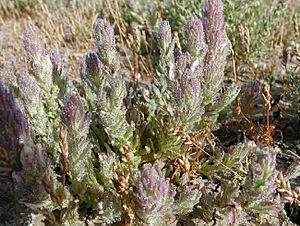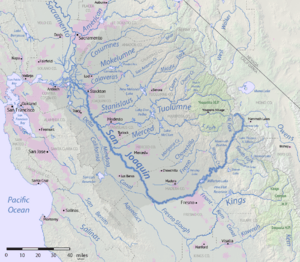Chloropyron palmatum facts for kids
Quick facts for kids Chloropyron palmatum |
|
|---|---|
 |
|
| Conservation status | |
| Scientific classification | |
| Genus: |
Chloropyron
|
| Species: |
palmatum
|
| Synonyms | |
|
|
Chloropyron palmatum, also known as the palmate salty bird's-beak, is a very rare flowering plant. It belongs to the Orobanchaceae family. This plant used to be called Cordylanthus palmatus. It's special because it grows in salty, wet areas.
Contents
What's in a Name?
This plant has a few common names, like palmate salty bird's-beak and Palmate-bract bird's-beak. These names describe how its leaves look a bit like a hand (palmate) and how it grows in salty places.
How Scientists Named This Plant
Scientists give plants special scientific names. These names can sometimes change as they learn more.
Early Discoveries
In 1918, a botanist named Roxana Stinchfield Ferris first described this plant. She gave it the name Adenostegia palmata. Another botanist, James Francis Macbride, later moved it to a different group, calling it Cordylanthus palmatus.
New Discoveries, New Names
In 2009, a group of scientists led by Tank studied the Cordylanthus group more closely. They decided to split it into three different groups. Because of this, Cordylanthus palmatus was moved to a new group called Chloropyron. So, its official scientific name became Chloropyron palmatum.
What Does It Look Like?
Chloropyron palmatum is an annual herb. This means it lives for only one growing season and has soft, green stems. It usually grows about 10 to 30 centimeters (4 to 12 inches) tall.
Plant Features
The plant is a gray-green color and has tiny hairs. It often looks like it's covered in salt crystals. This is because it can get rid of extra salt from its leaves.
Its leaves are long and thin. The special leaves around the flowers, called bracts, are shaped like a hand with several lobes.
Flowers and Spikes
The flowers grow in a thick, tall spike that can be up to 15 centimeters (6 inches) long. Each flower is about 2 centimeters (0.8 inches) long. It has a fuzzy white pouch, sometimes with a purple tint. This pouch is protected by darker green leaf-like parts called sepals.
Where Does It Live?
This plant is only found in one specific area, which scientists call endemic. It lives in the Central Valley of California. It has been seen in counties like Colusa, Yolo, Alameda, San Joaquin, Madera, and Fresno.
Current Locations
Sadly, this plant has disappeared from some areas, like San Joaquin County. Today, it is known to grow in about 14 different places. These include areas near Kerman, Tranquillity, Firebaugh, Livermore, and Colusa. Sometimes, plants can reappear from seeds hidden in the soil when conditions are right.
Its Special Home
Chloropyron palmatum has always been rare. This is because it needs a very specific type of habitat to grow. It lives in places called "alkali sinks."
Alkali Sinks
An alkali sink is a flat area that gets flooded during certain seasons. The soil in these areas is very salty and alkaline (which means it has a high pH). Only special plants that can handle salt, called halophytes, can grow here. Other plants that grow with it include iodine bush and alkali heath.
How It Gets Food
This plant is also a hemiparasite. This means it can make some of its own food using sunlight, but it also gets some nutrients by connecting to the roots of other plants. It grows at altitudes from 5 to 155 meters (16 to 500 feet) and flowers from May to October.
Why It Needs Our Help
This plant is very rare and needs protection.
Protected Status
The United States government has listed Chloropyron palmatum as an endangered species since 1986. The state of California also listed it as endangered in 1984. This means it is at high risk of disappearing forever.
Main Threats
The biggest danger to this plant is the loss of its special habitat. People are changing these areas for farms and new buildings. Other problems include changes in water flow, damage from off-road vehicles, and too much grazing by animals like cows. Protecting its unique home is key to helping this plant survive.



